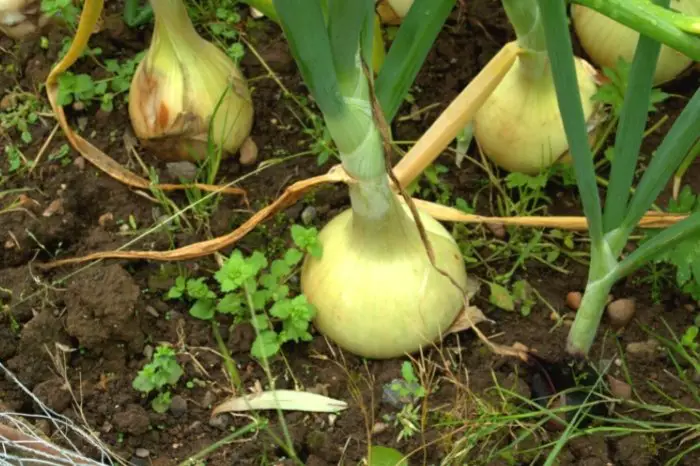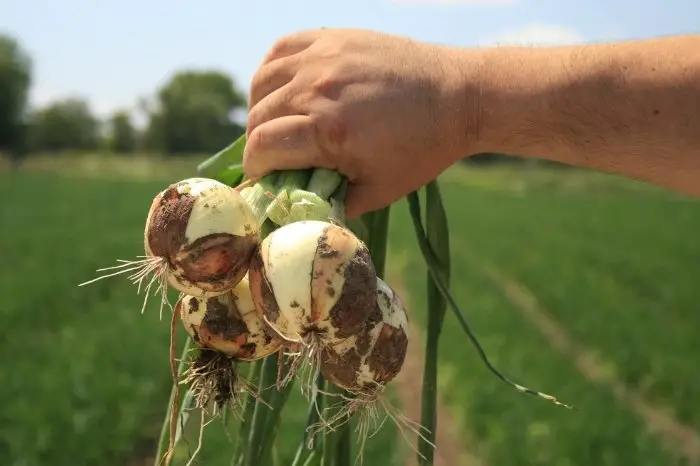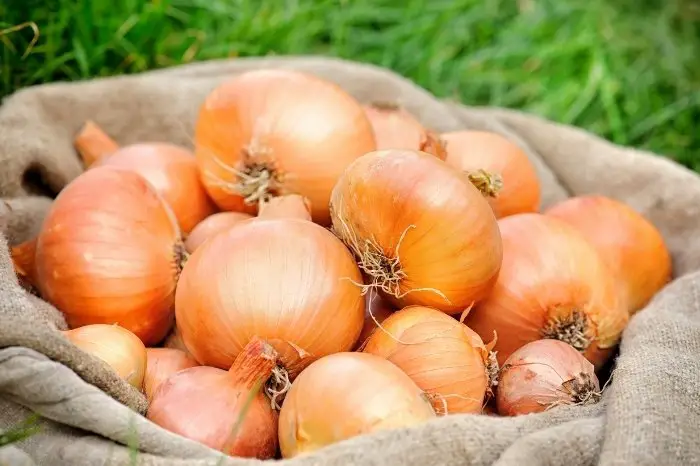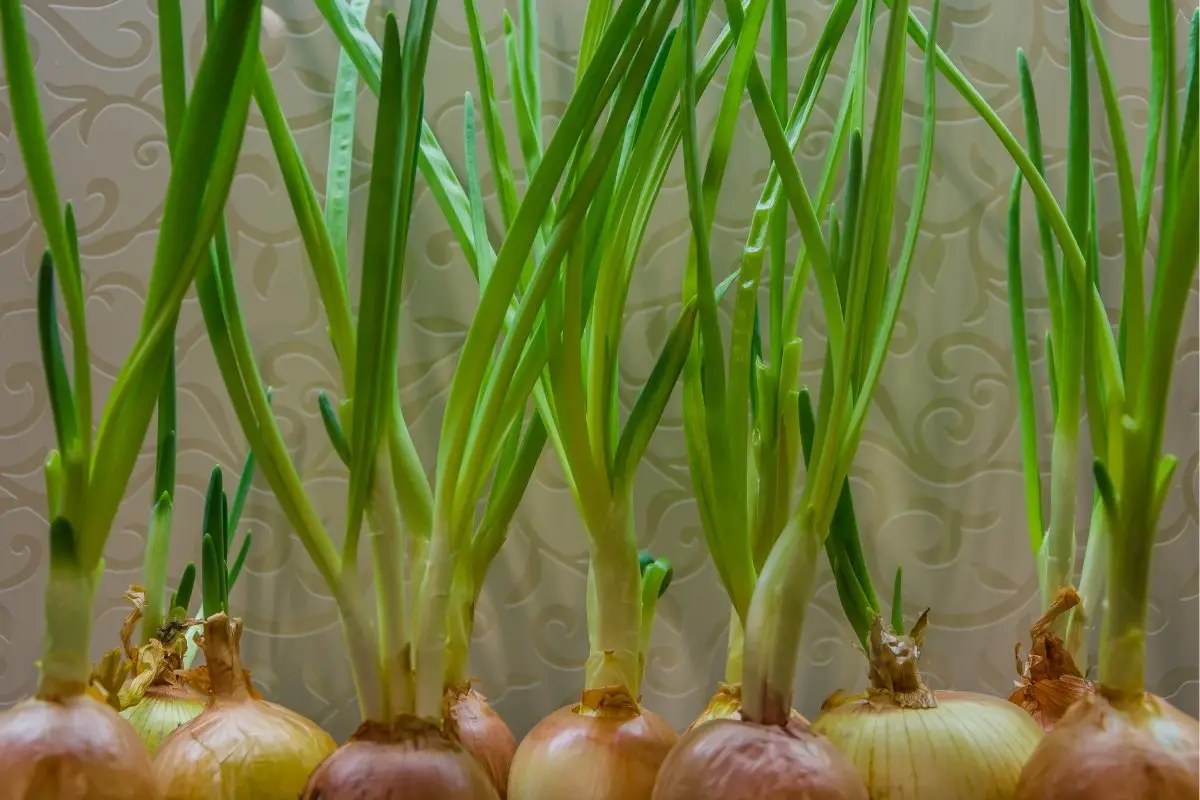Last Updated on March 23, 2022 by Fabiola L.
We will look at how to grow yellow onions as one of the easiest and most popular vegetables to grow in your garden.
Yellow onion is one of the most indispensable and flavorful ingredients to cook with. Not only do they add flavor and flair to dishes, but they also do well in most USDA hardiness zones. You can experiment with raw onions in salads or toss them in soups; you can’t go wrong with any onion recipe.
How To Grow Yellow Onions – Choosing The Right Growing Environment
-
-
Soil. Yellow onions require the proper growing environment to thrive. Provide them with rich, well-draining soil nourished with compost manure to encourage their growth. The soil you choose for growing yellow onions should be loose, fertile, and well-drained. Onions require loose soil with a substantial soil depth. If growing your onions on a raised or box that provides them with at least 4 to 6 inches of soil for the onions to grow. Plant them at least 4 inches deep when growing them in a garden. Shallow soils will cause your onions to become stunted and may not grow at all. Yellow onions do not do well in lumpy or clay-like soil, and standing water causes root rot, quickly ruining your onions.
-
Sunlight. Onions thrive when planted in full direct sunlight. However, if you receive average sunlight, allow them to have a full day of direct sunlight. If your area experiences too much sun, it is advisable to provide at least 6 hours of full sun and partial shade later in the day.
-
Raised Beds. Yellow onions do well in raised beds because the soil is looser and will provide the correct depth when planting.
-
Spacing. Yellow onions love plenty of spacing to grow and mature properly. Plant each onion at least 4 or 5 inches apart with 12 inches in between rows or 6 to 8 inches evenly spaced plants if you are planting in a grid. If you don’t provide enough space between the plants, your onions will become stunted. Also, you will provide more opportunities for weeds and bugs to destroy your onions and cause damage due to overcrowding. The correct spacing also helps avoid mould and fungus development that thrives in overcrowded onions.
-

Plants You Can Grow Together With Yellow Onions
Companion plants help protect your onions, or your onions can also protect them from pest infestation and diseases. There are several options you can plant near your onions with mutual benefits relationship, which increases the output and success of the yellow onion plants. Some good companion plants for yellow onions include
-
-
Carrots onions drive away carrot flies
-
Cabbage onions repel the common cabbage pests
-
Chamomile has anti-fungal ability to protect the onion bulbs
-
Read more about When Should Onions Be Planted?
Avoid Growing These Plants Near Yellow Onions
Some plants do not get along with yellow onions. There are various reasons why they don’t, as we will see below. Avoid planting yellow onions together or near these plants.
-
-
Peas these plants risk getting flavor contamination from onions
-
Pole beans the tendrils from these beans can choke the onion stalks hindering their growth
-
Asparagus these plants have a chemical incompatibility that causes trouble for both onions and asparagus.
-
Onions are generally good companions to most garden plants; except for the few listed above, be sure to look into specific varieties of water the plants you’re choosing to grow to make sure they are compatible.
How To Grow Yellow Onions From Seeds Or Planting Sets
You can grow yellow onions from either seeds or plant starts. Whichever method you choose will impact the timing and length of the harvest.
8 Onion Seeds Variety Pack Heirloom, Non-GMO, Onion Seed Set
Growing Yellow Onion From Seed
Yellow onions do well when grown from seed, but you will need to start them indoors before the last day of the frost. Plant your seeds at least 8 to 10 weeks before the last frost date in your area.
Transplant your seedlings outdoors after about 4 weeks of hardening off to avoid transplanting shock from affecting them. Water and fertilize your soil before transplanting to provide the proper nutrients for your plants. Ensure that you water your onions immediately after transplanting.
Your yellow onions will mature at least 5 months after planting the seeds.
Growing Yellow Onions From Planting Sets
Onion sets give you a quick harvest time and reduce the danger of transplanting shock. Plant your onion sets directly into the ground with the pointy end up. The roots will grow from the rounded end.
When planted from sets, yellow onions are ready for harvest after about two and a half months. You can buy your onion sets from your nearest gardening supplies seller or have them mailed to you at the proper planting time.
Once you receive your planting sets go ahead and plant them immediately without storing them.
Providing The Right Care For Yellow Onions
Yellow onions are easy to care for and require low maintenance. You will know you are taking good care of your yellow onions if they display
-
-
Strong upright stalks
-
A consistent stalk color of dark green
-
No damage masks or any extensive damage to the stalks
-
However, if you notice any illness or trouble with your onion, it is best to treat it with urgency. If you notice any of these signs, it shows your onions are affected and needs treatment quickly
-
-
Stunted growth
-
Slowed growth before maturity
-
Visible mould or discoloration of the leaves
-
Wilting stalks
-
How Much Water Do Your Yellow Onions Require
Yellow onions require a substantial amount of watering right from planting to the end of the growing season.
If you notice your onion tops becoming cracked or the soil around the bulbs appearing dry, it means they require more water. If the stalks have a yellowish color, this means you are overwatering them. Strike a balance between the right amount of water and too much water to avoid water logging your plants and killing them.
Avoid watering your yellow onions directly overhead with a hose, which can damage the stalks. Instead, water them directly onto the soil or use irrigation horses to deliver water at the base of the plant.
When your onions are ready for harvest, cease watering immediately to let the soil dry out before harvesting.
How To Harvest Yellow Onions
After all the hard work of planting, watering, cultivating, and nourishing your yellow onions, it’s time to harvest your crop. It is important to harvest your onions correctly to increase their shelf life.
Your yellow onions will be ready for harvest mid-to-late summer. The stalks will fall over and wither even with regular watering, meaning they are ready for harvest. When you see this indication, avoid watering them anymore. Shortly after, you will see the top of the onion bulb popping out of the soil.

Harvest your onions quickly to avoid them rotting in the ground. It is advisable to harvest your onions in the morning before the temperature gets too hot. They will dry out better if there’s a gradual heat increase instead of the shock of rising temperatures from damp soil to very high temperatures.
When harvesting onions, you can pull them straight out of the soil by the family holding the stocks in your hand.
Click here to Learn more About:
Storing Your Harvested Yellow Onions
Once you have pulled your onions from the soil, it is essential to store them in the right place and preserve them for use in the future.
Lay your onions in a single layer on cardboard or newspaper, allowing a few inches in between them. Ensure if you keep them in a warm but ventilated area, fly car garage in the summer season, or a table outside in the patio. If you choose to store them, check for cool weather or rain that could mess up your onions.
After a few days, the onions will have cured with the outer skin appearing the same way you find it at the grocery store. To know that your onions have cured enough checkout for dry, flaky, and papery skin. The stringy dried fruits are also easy to rub off; however, be careful not to damage the actual body of the onion. You can also leave the tops still attached to the onion to braid or twist them for storage. If you choose to remove the stalks, leave a few inches so that you don’t damage the top side of the onion.
Store your cured onions in bunches by the stalks or store them in a mesh bag in a cool, dry place away from any moisture. The best temperature for storage is 50 to 60 degrees Fahrenheit.

Final Thoughts
With the knowledge of how to grow yellow onions, it is best to add another vegetable to your gardening journey. General onions are rarely affected by pests or diseases; therefore, the growing journey should be easy even for a new gardener.
Caroline is a gardener who loves to get down to the nitty–gritty of gardening. She proudly proclaims herself as a ‘dirt worshipper‘ and can often be found deep in the garden, covered in soil and singing to her plants. As a self–proclaimed ‘plant whisperer‘, Caroline believes that plants need love and attention just like any other living thing, and she loves to give them both. When she‘s not tending to her garden, you can often find her researching the latest gardening trends, or teaching others how to make their gardens thrive



